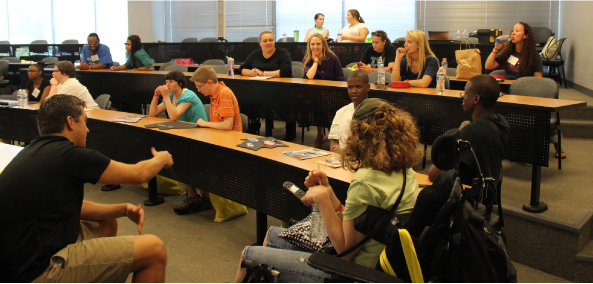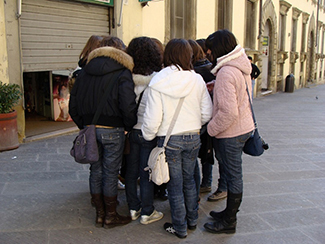110 Self-Presentation
Learning Objectives
By the end of this section, you will be able to:
- Describe social roles and how they influence behaviour
- Explain what social norms are and how they influence behaviour
- Define the concept of a “script” in the context of social psychology
As you’ve learned, social psychology is the study of how people affect one another’s thoughts, feelings, and behaviours. We have discussed situational perspectives and social psychology’s emphasis on the ways in which a person’s environment, including culture and other social influences, affect behaviour. In this section, we examine situational forces that have a strong influence on human behaviour including social roles, social norms, and scripts. We discuss how humans use the social environment as a source of information, or cues, on how to behave. Situational influences on our behaviour have important consequences, such as whether we will help a stranger in an emergency or how we would behave in an unfamiliar environment.
Social Roles
One major social determinant of human behaviour is our social roles. A social role is a pattern of behaviour that is expected of a person in a given setting or group (Hare, 2003). Each one of us has several social roles. You may be, at the same time, a student, a parent, an aspiring teacher, a son or daughter, a spouse, and a lifeguard. How do these social roles influence your behaviour? Social roles are defined by culturally shared knowledge. That is, nearly everyone in a given culture knows what behaviour is expected of a person in a given role. For example, what is the social role for a student? If you look around a college classroom you will likely see students engaging in studious behaviour, taking notes, listening to the professor, reading the textbook, and sitting quietly at their desks (Figure SP.7). Of course you may see students deviating from the expected studious behaviour such as texting on their phones or using Facebook on their laptops, but in all cases, the students that you observe are attending class—a part of the social role of students.

Social roles, and our related behaviour, can vary across different settings. How do you behave when you are engaging in the role of a child attending a family function? Now imagine how you behave when you are engaged in the role of employee at your workplace. It is very likely that your behaviour will be different. Perhaps you are more relaxed and outgoing with your family, making jokes and doing silly things. But at your workplace you might speak more professionally, and although you may be friendly, you are also serious and focused on getting the work completed. These are examples of how our social roles influence and often dictate our behaviour to the extent that identity and personality can vary with context (that is, in different social groups) (Malloy, Albright, Kenny, Agatstein & Winquist, 1997).
Social Norms
As discussed previously, social roles are defined by a culture’s shared knowledge of what is expected behaviour of an individual in a specific role. This shared knowledge comes from social norms. A social norm is a group’s expectation of what is appropriate and acceptable behaviour for its members—how they are supposed to behave and think (Deutsch & Gerard, 1955; Berkowitz, 2004). How are we expected to act? What are we expected to talk about? What are we expected to wear? In our discussion of social roles we noted that colleges have social norms for students’ behaviour in the role of student and workplaces have social norms for employees’ behaviours in the role of employee. Social norms are everywhere including in families, gangs, and on social media outlets. What are some social norms on Facebook?
Everyday Connection
Tweens, Teens, and Social Norms
My 11-year-old, Shiloh, recently told me they needed shorts and shirts for the summer, and that they wanted me to take them to a store at the mall that is popular with preteens and teens to buy them. I have noticed that many kids have clothes from that store, so I tried teasing Shiloh. I said, “All the shirts say ‘Aero’ on the front. If you are wearing a shirt like that and you have a substitute teacher, and the other kids are all wearing that type of shirt, won’t the substitute teacher think you are all named ‘Aero’?”
Shiloh replied, in typical 11-year-old fashion, “You are not funny. Can we please go shopping?”
I tried a different tactic. I asked Shiloh if having clothing from that particular store will make them popular. They replied, “No, it will not make me popular. It is what the popular kids wear. It will make me feel happier.” How can a label or name brand make someone feel happier? Think back to what you’ve learned about lifespan development. What is it about pre-teens and young teens that make them want to fit in (Figure SP.8)? Does this change over time? Think back to your high school experience, or look around your college campus. What is the main name brand clothing you see? What messages do we get from the media about how to fit in?

Scripts
Because of social roles, people tend to know what behaviour is expected of them in specific, familiar settings. A script is a person’s knowledge about the sequence of events expected in a specific setting (Schank & Abelson, 1977). How do you act on the first day of school, when you walk into an elevator, or are at a restaurant? For example, at a restaurant in the United States, if we want the server’s attention, we try to make eye contact. In Brazil, you would make the sound “psst” to get the server’s attention. You can see the cultural differences in scripts. To an American, saying “psst” to a server might seem rude, yet to a Brazilian, trying to make eye contact might not seem an effective strategy. Scripts are important sources of information to guide behaviour in given situations. Can you imagine being in an unfamiliar situation and not having a script for how to behave? This could be uncomfortable and confusing. How could you find out about social norms in an unfamiliar culture?

